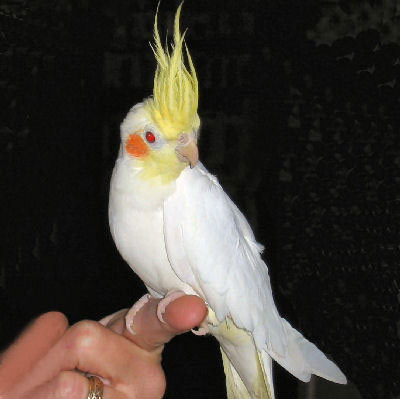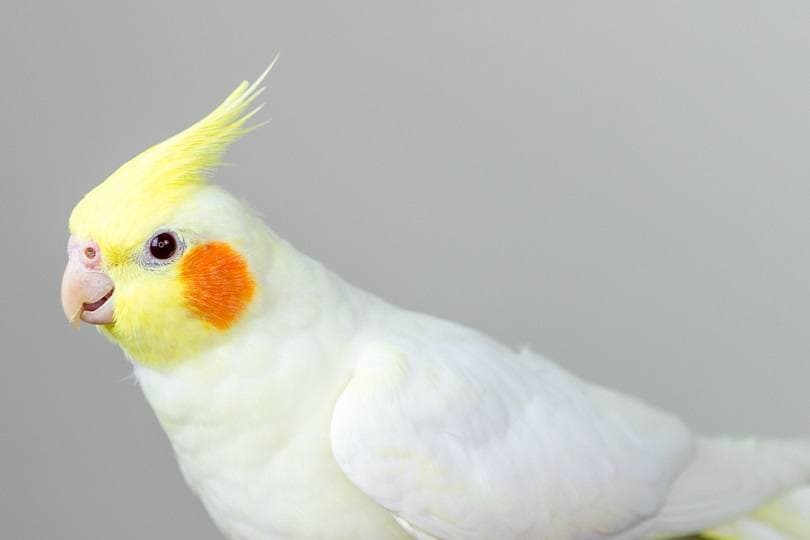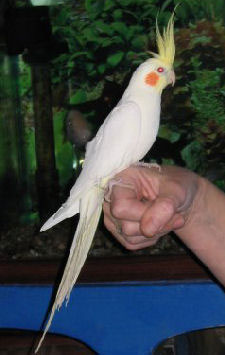
The Lutino Cockatiel is a beautiful pet bird, with a mostly white to light-yellow body and orange cheek patches!
The gorgeous Lutino Cockatiel was the second cockatiel mutation to be established, with the first being the Pied Cockatiel. Unlike the Pied however, the Lutino Cockatiel took the aviculture world by storm. It became an immediate hit because it was so like a miniature white Cockatoo with a pale yellow breast and almost white body, tail, and wings.The head and crest are a primrose yellow and both sexes have bright orange cheek patches and red eyes. This was like the story of the ugly duckling turning into a beautiful swan.
All Lutino Cockatiels are descended from one single male cockatiel. This bird was owned by a Mr. Cliff Barringer of Florida, USA. Mr. Barringer had bred 14 normal offspring from his pair of what appeared to be normal Grey Cockatiels. It was in a nest of two of these youngsters, in 1958, that he was surprised with a baby with pink eyes. It did take another two years for Mr. Barringer to mate a female lutino daughter back to the father to produce the first male lutino. Shortly after, much of Mr Barringer’s stock was purchased by Mrs. E. L. Moon, once a curator of the Florida Parrot Jungle. She subsequently named her lutino offspring ‘Moonbeams’, and from here Lutino Cockatiel’s spread throughout the world.
Cockatiels are probably the most popular of the parrot family with their main competition being the Budgerigar (referred to as the Parakeet in the United States). They are hardy, easily handle changes in their home, and are easy to breed. On top of that, keeping a cockatiel as a pet is easy because they are not noisy parrots and they are comfortable when left alone for long periods of time.
Cockatiel’s evolved as nomadic creatures, surviving in a variety of diverse and rugged habitats. They are constantly on the move, changing locations with the seasonal fluctuations of food and water supplies. This native habitat and their adaptive behavior has made them well suited as pets.
For more information about the care of Cockatiels see:
Guide to a Happy, Healthy Cockatiel
- Kingdom: Animalia
- Phylum: Chordata
- Class: Aves
- Order: Psittaciformes
- Family: Cacatuidae
- Genus: Nymphicus
- Species: hollandicus
Scientific Name
Distribution
The Lutino Cockatiel is a strain developed by breeders and is not seen in the wild. Grey Cockatiels are found over most of Australia except the coastal areas and most of Tasmania. Tasmania, an island state of Australia, has many of the parrots found in Australia but the cockatiel is not present there. It is thought that though they are one of Australia’s fastest flyers, their flying strength is apparently not sufficient to help them bridge the waterway that separates the island from the Australian mainland.
Description
Cockatiels are considered parrots, as can be seen by the shape of their beak. Cockatiels are probably the most popular of the parrot family. They are closely related to the Cockatoos, and like Cockatoos they are members of the Cacatuidae family.
As members of the Cacatuidae family they too have an erectile crests. This cute little crest will be held erect when they are stimulated and excited, flattened when they are feeling angry, defensive, or submissive, and somewhere in between when they are in their normal ‘hanging out’ state. Unlike the other members of this family, however, they have long tails. The tail makes up about half of their total length and gives them more of a parakeet type appearance
The Lutino Cockatiel is a spectacularly beautiful bird. It is yellow – white bird with bright orange cheek patches and red eyes. The lutino gene is known as a sex-linked recessive gene. It prevents the production of the black/gray colors, the ‘melanin’ pigment, that is found in a normal Grey Cockatiel. The Lutino Cockatiel can be readily combined with the pearl, pied, cinnamon and whiteface mutations to produce spectacularly colored varieties.
The only negative trait to the Lutino’s is that a bald patch can occur on the head just behind the crest. When these birds were first bred this was especially pronounced. Today, as a result of successful selective breeding practices, this trait is being greatly reduced and many specimens now have total feather coverage on the head.
See descriptions of sexual differences for this pet bird cockatiel below, under the breeding cockatiels section.
Size – Weight
These birds get up to 12 inches (30 cm) and weigh 3 to 4 ounces.
Care and feeding
Good sized bird cages are a must for good cockatiel care. A roomy cockatiel cage is required unless the bird is to be let out for extended periods. The cage for a cockatiel should measure a minimum of 24″ length by 18″ high and 18″ wide. This will leave enough room for several toys and still give the bird room to fully stretch his/her wings without hitting them. Many birds can spend most of their time on a playpen or parrot perch. Bird food consists of a variety of sprouts, seeds, nuts, fruits, vegetables, and commercial pellets.
See About Cockatiels: Housing and About Cockatiels: Care and Feeding for more information.
Social Behaviors
Cockatiels travel in flocks in the wild and this influences cockatiel behavior in captivity. Their social ‘flock’ disposition along with their native habitat makes them well suited as pets. They are hardy, adapt easily to change, and are easy to breed. A big plus is that cockatiels are not noisy and can be left alone for long periods of time. They make a very loving and devoted pet if bonded properly.
For taming cockatiels and cockatiel training, see About Cockatiels: Handling and Training.
Activities
Common bird activities for cockatiels, they like to climb and play. Cockatiel bird care includes providing lots of bird toys and excercise. Give them plenty of time outside the cage if possible, a playpen works well for this. Many cockatiels can learn to talk and whistle, especially the males.
See About Cockatiels: Activities for more information.
Breeding/Reproduction
Cockatiel breeding can be a very rewarding experience. Cockatiels will readily nest provided they have a nest box and some material to construct the nest from. They lay one egg every other day until they have laid about 5 eggs. The incubation period is 17 – 22 days. After hatching the young birds will open their eyes at 9 days of age.
|
This is a good time to start hand feeding if you don’t want to incubate the eggs yourself. Incubation and raising the chicks yourself requires dedication since the young chicks will need feedings every two hours for the first couple of weeks. Likewise, you can pull them from the nest earlier than 9 days, but with greater risk to the chick and greater effort on your part with frequent feedings. After about 18 days the orange cheek patch will appear on the babies. At about 30 days they will look like adult birds, and will fledge at about 35 days of age.
For more information on cockatiel breeding, see About Cockatiels: Breeding/Reproduction.
Sexual differences
There are a lot of opinions about how to sex these birds but usually they are just indicators and not sure ways to tell. For Lutino Cockatiel, just like for common grey cockatiels, juveniles will have barring on the underside of the tail. This barring is lost with the male’s first molt, generally at about 6 months. However, on the female the barring is retained, but it is It is very hard to distinguish mature cocks from hens because the barring can be quite faint. A DNA test will be your best bet to know what sex your pet is.
Potential Problems
The cockatiel health is easy to maintain as these are very hardy birds, but for all pet birds there are potential problems For optimum bird health care for your cockatiel, it is good to know what signs of illness to be aware of.
For information about cockatiel health, see About Cockatiels: Problems.
Availability
The Lutino Cockatiel is one of the readily available cockatiels for sale, but it is not as common as the Grey Cockatiel and is usually more expensive. There are also lots of other color mutations readily available including pearl, pied, cinnamon, and white-faced varieties.
Featured Image Credit: Wirestock Creators, Shutterstock

